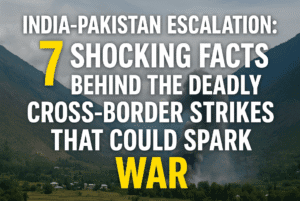India-Pakistan Escalation: 7 Shocking Facts Behind the Deadly Cross-Border Strikes That Could Spark War
India launched targeted airstrikes, Operation Sindoor, on Pakistan-administered Kashmir and mainland Pakistan—including Punjab’s Bahawalpur—in retaliation for a April 22 militant attack in Pahalgam that killed 26 civilians. Delhi framed the strikes as anti-terror action, but Pakistan reported 31 civilian deaths, calling it “unprovoked aggression,” and retaliated with shelling that killed 15 on India’s side. Islamabad also claimed to down Indian aircraft, though unverified.
The strikes mark India’s first major attack on mainland Pakistan since 1971, escalating a decades-old Kashmir conflict marked by wars and proxy militancy. Global leaders urged restraint, wary of nuclear stakes, while analysts warn the unprecedented scale risks spiraling retaliation. Civilians on both sides face displacement and casualties, deepening Kashmir’s humanitarian crisis. With diplomacy strained, the crisis underscores how historical grievances and political posturing threaten regional stability, leaving the world anxious over a potential tipping point.

India-Pakistan Escalation: 7 Shocking Facts Behind the Deadly Cross-Border Strikes That Could Spark War
The longstanding tensions between India and Pakistan reached a dangerous crescendo this week as India launched targeted airstrikes—dubbed Operation Sindoor—against sites in Pakistan and Pakistan-administered Kashmir. The operation, named for the red vermilion symbolizing Hindu matrimony, underscores the deeply personal toll of a recent militant attack that killed 26 civilians, predominantly Hindu pilgrims, in Indian-administered Kashmir. Here’s a nuanced analysis of the crisis, its roots, and what lies ahead.
The Trigger: Pahalgam’s Tragedy
On April 22, militants opened fire on tourists in Pahalgam, a serene valley in Indian-administered Kashmir. The attack, which left 25 Indians and one Nepali national dead, marked the deadliest assault on civilians in the region in over two decades. Survivors recounted harrowing scenes of gunmen singling out Hindu men, leaving families shattered. India swiftly blamed Pakistan-based groups Lashkar-e-Taiba and Jaish-e-Mohammad, though Islamabad denied involvement.
India’s Retaliation: Operation Sindoor
In the early hours of May 7, India struck nine locations, including six in Pakistan-administered Kashmir and three in mainland Pakistan—notably Punjab’s Bahawalpur, a first since the 1971 war. Delhi framed the operation as a “measured response” targeting “terrorist infrastructure” while avoiding military installations. However, Pakistan reported civilian casualties, with 31 dead and 57 injured, accusing India of violating sovereignty.
Key Strike Sites:
- Muzaffarabad & Kotli (Pakistani Kashmir): Alleged militant hubs.
- Bahawalpur (Punjab): Home to Jaish-e-Mohammad-linked seminaries.
- Muridke (Punjab): Associated with Lashkar-e-Taiba.
Pakistan’s Response and Escalating Toll
Pakistan retaliated with artillery shelling across the Line of Control (LoC), killing 15 and injuring 43 on India’s side, per Indian officials. Islamabad also claimed to have downed five Indian aircraft and a drone, though Delhi remained silent on these losses. Independent verification remains elusive, but wreckage in Kashmir’s Wuyan village suggested a downed fighter jet’s fuel tank, possibly from a French-made Rafale or Mirage.
Human Cost:
- Displaced families in border villages.
- Srinagar airport closures and heightened military alerts.
Historical Context: A Cycle of Violence
Kashmir, partitioned between India and Pakistan since 1947, has fueled three wars and decades of insurgency. Recent flashpoints include:
- 2016 Uri Attack: India’s “surgical strikes” on Pakistani Kashmir.
- 2019 Pulwama Bombing: Indian airstrikes in Balakot, met with Pakistani retaliation.
This latest escalation breaks precedents by striking mainland Pakistan and multiple targets, signaling Delhi’s hardened stance under PM Narendra Modi.
International Reactions: Calls for Restraint
Global leaders urged de-escalation:
- UN Secretary-General António Guterres: Emphasized “maximum restraint.”
- U.S. Secretary of State Marco Rubio: Held crisis talks with Indian officials.
- EU & UK: Stressed dialogue amid nuclear stakes.
Notably, Pakistan’s PM Shehbaz Sharif termed the strikes “an unprovoked act of war,” vowing retaliation, while India’s Defense Minister Rajnath Singh declared, “Victory to Mother India.”
Expert Insights: Crossing Thresholds
Analysts warn of perilous precedents. Asfandyar Mir of the Stimson Center notes India’s strikes on Punjab and scale of targets mark a strategic shift, likely provoking “significant retaliation.” The risk of miscalculation looms large, compounded by both nations’ nuclear arsenals.
What Next?
- Diplomatic Channels: Pressure mounts for third-party mediation, though historical distrust between India and Pakistan complicates talks.
- Economic Fallout: Border closures and visa suspensions disrupt trade and families divided by the LoC.
- Domestic Politics: Modi’s strongman rhetoric ahead of 2025 Indian elections contrasts with Sharif’s fragile coalition, incentivizing posturing.
Conclusion: A Fragile Line
While Operation Sindoor symbolizes India’s resolve, it risks entangling both nations in a cycle of retaliation. The strikes’ civilian toll and downed aircraft underscore the volatility. For Kashmiris, already scarred by decades of conflict, the escalation deepens their humanitarian crisis. As the world watches, the path to de-escalation hinges on backchannel diplomacy and global pressure—lest a miscalculation sparks a conflict with unimaginable consequences.
You must be logged in to post a comment.